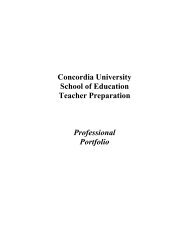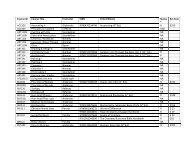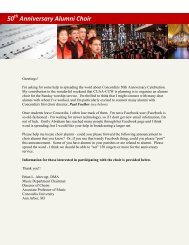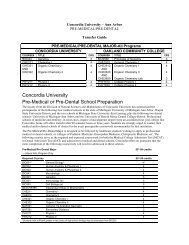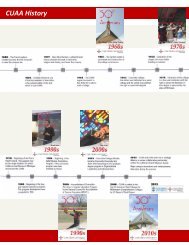2009â2010 Academic Catalog - Concordia University Ann Arbor
2009â2010 Academic Catalog - Concordia University Ann Arbor
2009â2010 Academic Catalog - Concordia University Ann Arbor
Create successful ePaper yourself
Turn your PDF publications into a flip-book with our unique Google optimized e-Paper software.
<strong>Concordia</strong> <strong>University</strong> <strong>Ann</strong> <strong>Arbor</strong> 2009–2010 <strong>Academic</strong> <strong>Catalog</strong><br />
Applying<br />
Step One: Obtain a Personal Identification Number (PIN#).<br />
This number is required to fill out and sign the FAFSA form (step 2) online. Go to www.pin.ed.gov. Click on<br />
“Pin Request and Information: which takes you to the “Requesting Your U.S. Department of Education PIN”<br />
page. Then click on the appropriate link. Enter your name as it appears on your Social Security card and a valid<br />
email address or home address. Within 1 to 5 days you will receive an email notice, if you provided a valid email<br />
address, giving directions to access your PIN# online. If you do not provide a valid email address, your PIN will<br />
be mailed to you within 7-10 days.<br />
Step Two: Complete the Free Application for Federal Student Aid (FAFSA)<br />
Go to www.pin.ed.gov or complete the paper application. You will need your completed 2005 federal tax return<br />
in order to complete the FAFSA correctly. <strong>Concordia</strong>’s school code is 002247.<br />
Step Three: Receive a Student Aid Report (SAR)<br />
Expect the SAR approximately 10 days after completing your FAFSA. You will receive an electronic SAR if you<br />
entered an email address or a paper one if you did not. Read it carefully. It is your official record that the federal<br />
processor received your FAFSA. Make sure all of the information is accurate. If you need to make any<br />
corrections, you can do that directly at www.fafsa.ed.gov or on the paper copy of the SAR.<br />
The results of the FAFSA will determine your "Estimated Family Contribution" or EFC. This is an estimate of<br />
how much the family can afford to pay for college. This information is sent to any school you list on the FAFSA.<br />
The Financial Aid Office will use it to determine how much aid you may be eligible to receive. The "EFC" will<br />
be subtracted from the cost of education at the school. The remaining amount is your "need" for financial aid.<br />
Step Four: <strong>Concordia</strong> Financial Aid Office determines eligibility<br />
Once you have been officially admitted to the academic program and registered for at least 6 undergraduate<br />
credits, or 5 graduate credits, the Office of Financial Aid will review your FAFSA information to determine your<br />
eligibility for financial aid. If no additional information is needed, you will be mailed an award letter, along with<br />
instructions on how to complete the loan application process.<br />
Packaging Policies<br />
Students are awarded all federal and state aid for which they are eligible based on the results of the FAFSA and<br />
availability of funds.<br />
Types of Financial Aid<br />
Grants and Scholarships<br />
Federal Pell Grant<br />
This is a federal grant that does not have to be repaid. To determine if you are eligible financially, the US<br />
Department of Education uses a standard formula to evaluate the information you report on your FAFSA. Your<br />
eligibility depends on the cost of attendance and your enrollment status (full-time, three-quarter time, etc.)<br />
Michigan Tuition Grant (Listed as Michigan Scholarship/Grant on Award)<br />
The Michigan Tuition Grant is available to students who attend private schools in Michigan and have been<br />
Michigan residents for at least one year. The State of Michigan uses a standard formula to award MTG to<br />
students who are able to demonstrate financial need. FAFSA data is used for this and an approved, correct<br />
FAFSA must be on file by the deadline to get Michigan Grant aid. The state deadline for 2006-07 is July 1, 2006.<br />
The MTG does not have to be repaid. Students should make sure to list <strong>Concordia</strong> in the FIRST position on the<br />
FAFSA if they want their Michigan Tuition Grant to be used at <strong>Concordia</strong>.<br />
Loans<br />
For Subsidized and Unsubsidized Stafford Loans, a student must complete Entrance Counseling before receiving<br />
funds for the first time, and must have an Exit Interview when they cease attendance or drop below half-time.<br />
Each loan also requires the student to complete a loan application or Master Promissory Note (MPN).<br />
<strong>Academic</strong> Year Amounts- Stafford Loan program<br />
Undergraduate annual loan limits<br />
First year students (0-27 credits) $6625<br />
Second year students (28-59 credits) $7500<br />
Third year and beyond (60+ credits) $10,500<br />
Pg. 87 of 118




